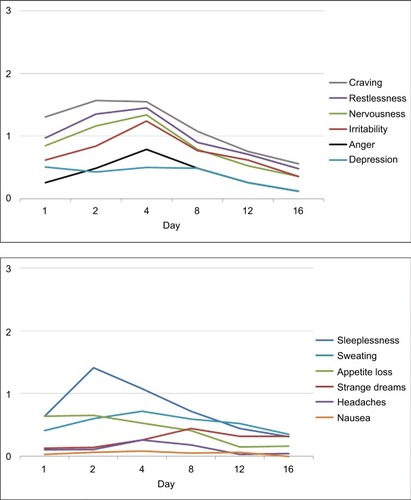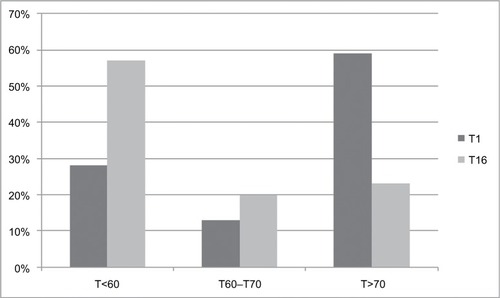Figures & data
Table 1 Clinical and laboratory studies on human CWS in the past 20 years
Table 2 Marijuana Withdrawal Checklist (MWC)
Figure 1 Courses of overall CWS post-cessation. The CWS usually lasts up to 3 weeks and its average peak severity (burden) is comparable to that of a moderate depression or alcohol withdrawal syndrome or in outpatient settings, similar to that of a tobacco withdrawal syndrome. Data from previous studies.Citation14,Citation36,Citation79

Figure 2 Mean and standard deviation of the (A) CWS checklist (MWC score according to previous studiesCitation24,Citation26,Citation37) and (B) the Clinical Global Impression Scale (CGI-S ScoreCitation80) during the course of the study. Reduced sample sizes on day 12 (n=35) and day 16 (n=28) due to regular dismissals and missed assessments are indicated by dashed lines. The effect size according to Cohen (Cohen’s d) was 1.1 for the CWS (day 1 to day 16), Cohen’s d ≥0.8 is defined to reflect a strong effect.Citation130 Vertical imaginary Y-axis: severity scores. Horizontal imaginary X-axis: time course.
Abbreviations: CWS, cannabis withdrawal syndrome; MWC, Marijuana Withdrawal Checklist.

Figure 3 Mean rating of single symptoms of the MWC (MWC score according to previous studiesCitation24,Citation26,Citation37); 4-point scale (0 = none, 1 = mild, 2 = moderate, 3 = heavy). Note the delayed occurrence of strange dreams.Citation25 Vertical imaginary Y-axis: severity scores. Horizontal imaginary X-axis: time course.

Figure 4 Significant improvement (p<0.001) of the subjective global distress of adult heavy cannabis users during inpatient qualified detoxification as measured by the Symptom Checklist 90, revised version (SCL-90-R).Citation129 Y-axis: percent of the sample (N=35); X-axis: global distress according to T-values: T<60: normal global distress; T>70: severe global distress;Citation129 T1 = admission day and T16 = last day (day 16) of the controlled inpatient qualified detoxification treatment.Citation113

